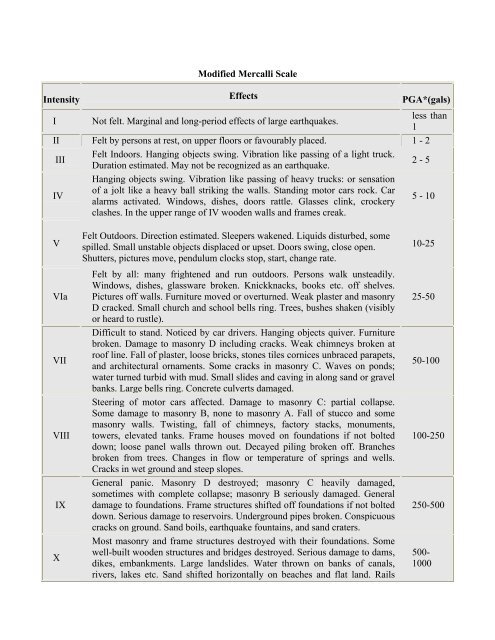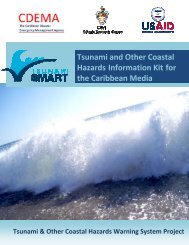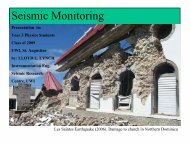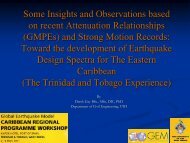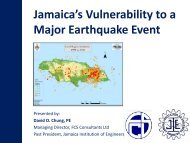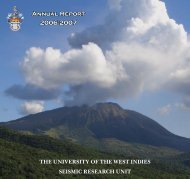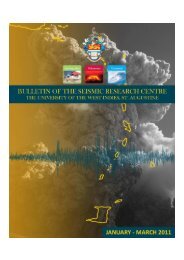Modified Mercalli Scale Intensity Effects PGA*(gals) I Not felt ...
Modified Mercalli Scale Intensity Effects PGA*(gals) I Not felt ...
Modified Mercalli Scale Intensity Effects PGA*(gals) I Not felt ...
- No tags were found...
You also want an ePaper? Increase the reach of your titles
YUMPU automatically turns print PDFs into web optimized ePapers that Google loves.
<strong>Modified</strong> <strong>Mercalli</strong> <strong>Scale</strong><strong>Intensity</strong> <strong>Effects</strong> <strong>PGA*</strong>(<strong>gals</strong>)I <strong>Not</strong> <strong>felt</strong>. Marginal and long-period effects of large earthquakes.less than1II Felt by persons at rest, on upper floors or favourably placed. 1 - 2IIIFelt Indoors. Hanging objects swing. Vibration like passing of a light truck.Duration estimated. May not be recognized as an earthquake.2 - 5IVHanging objects swing. Vibration like passing of heavy trucks: or sensationof a jolt like a heavy ball striking the walls. Standing motor cars rock. Caralarms activated. Windows, dishes, doors rattle. Glasses clink, crockeryclashes. In the upper range of IV wooden walls and frames creak.5 - 10VVIaVIIVIIIIXXFelt Outdoors. Direction estimated. Sleepers wakened. Liquids disturbed, somespilled. Small unstable objects displaced or upset. Doors swing, close open.Shutters, pictures move, pendulum clocks stop, start, change rate.Felt by all: many frightened and run outdoors. Persons walk unsteadily.Windows, dishes, glassware broken. Knickknacks, books etc. off shelves.Pictures off walls. Furniture moved or overturned. Weak plaster and masonryD cracked. Small church and school bells ring. Trees, bushes shaken (visiblyor heard to rustle).Difficult to stand. <strong>Not</strong>iced by car drivers. Hanging objects quiver. Furniturebroken. Damage to masonry D including cracks. Weak chimneys broken atroof line. Fall of plaster, loose bricks, stones tiles cornices unbraced parapets,and architectural ornaments. Some cracks in masonry C. Waves on ponds;water turned turbid with mud. Small slides and caving in along sand or gravelbanks. Large bells ring. Concrete culverts damaged.Steering of motor cars affected. Damage to masonry C: partial collapse.Some damage to masonry B, none to masonry A. Fall of stucco and somemasonry walls. Twisting, fall of chimneys, factory stacks, monuments,towers, elevated tanks. Frame houses moved on foundations if not bolteddown; loose panel walls thrown out. Decayed piling broken off. Branchesbroken from trees. Changes in flow or temperature of springs and wells.Cracks in wet ground and steep slopes.General panic. Masonry D destroyed; masonry C heavily damaged,sometimes with complete collapse; masonry B seriously damaged. Generaldamage to foundations. Frame structures shifted off foundations if not bolteddown. Serious damage to reservoirs. Underground pipes broken. Conspicuouscracks on ground. Sand boils, earthquake fountains, and sand craters.Most masonry and frame structures destroyed with their foundations. Somewell-built wooden structures and bridges destroyed. Serious damage to dams,dikes, embankments. Large landslides. Water thrown on banks of canals,rivers, lakes etc. Sand shifted horizontally on beaches and flat land. Rails10-2525-5050-100100-250250-500500-1000
ent slightly.XI Rails bent greatly. Underground pipelines completely out of service. **Damage nearly total. Large rock masses displaced. Lines of sight and levelXII**distorted. Objects thrown into the air.<strong>Not</strong>es:* PGA is the effective Peak Ground Acceleration during the earthquake. That is themaximum horizontal ground acceleration excluding high frequency spikes. 1 gal = 1cm/sec/sec. Since the intensity of gravity (g) is about 10 meters/sec/sec 10 <strong>gals</strong> isabout 1% of gravity** At the highest intensity levels damage potential is determined increasingly by theeffects of ground failure. Most types of ground are unable to sustain prolongedaccelerations much greater than 500 <strong>gals</strong>.Masonry A. Good workmanship, mortar and design: reinforced especially laterallyand bound together using steel, concrete etc. Designed to resist lateral forces.Masonry B. Good workmanship and mortar. Reinforced but not designed in detail; toresist horizontal forces.Masonry C. Ordinary workmanship and mortar. No extreme weaknesses like failingto tie in at corners but neither reinforced nor designed to resist horizontal forces.Masonry D. Weak materials such as adobe; poor mortar; low standards ofworkmanship; weak horizontally.(From Elementary Seismology by C.F. Richter, Published by W.F. Freeman )


